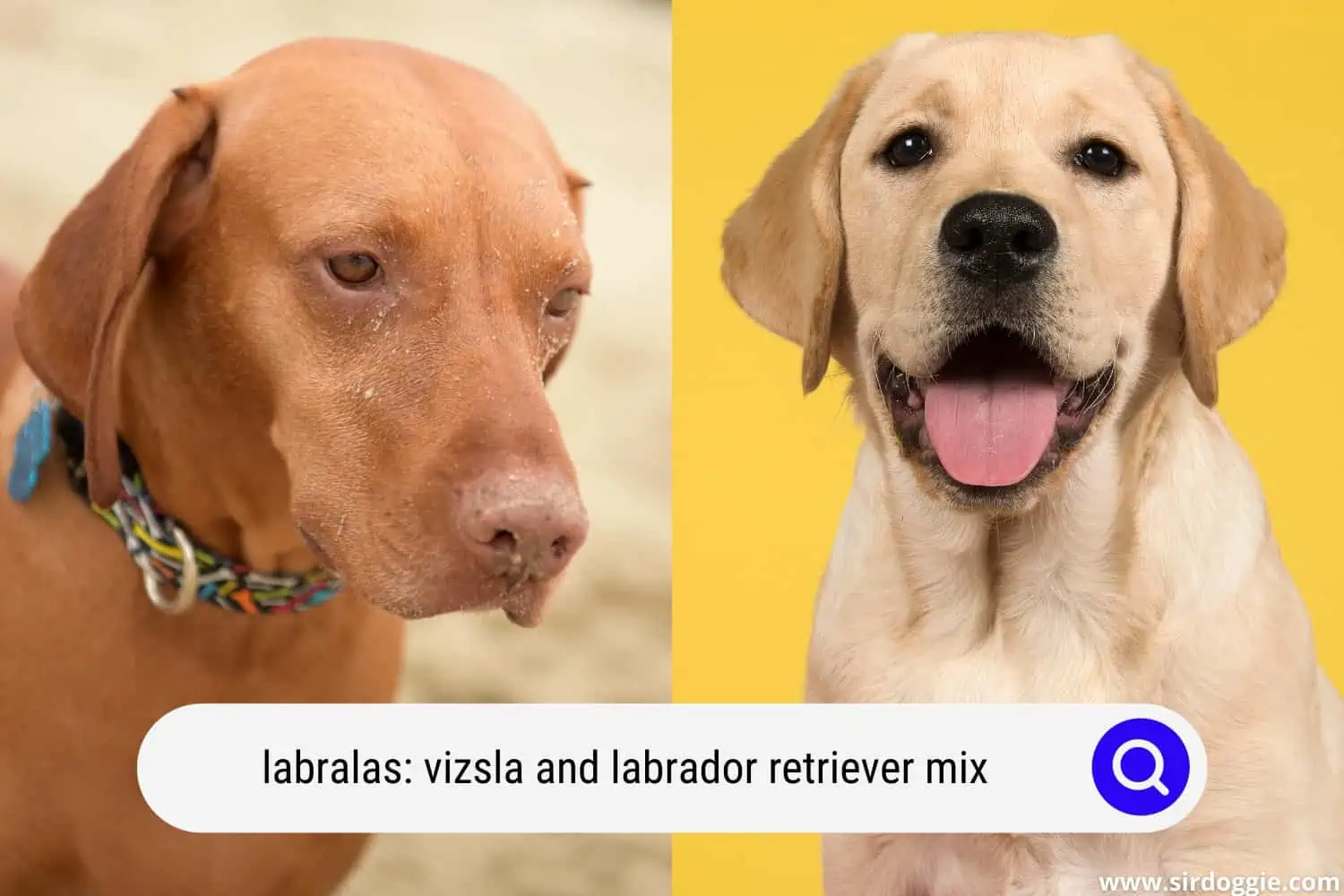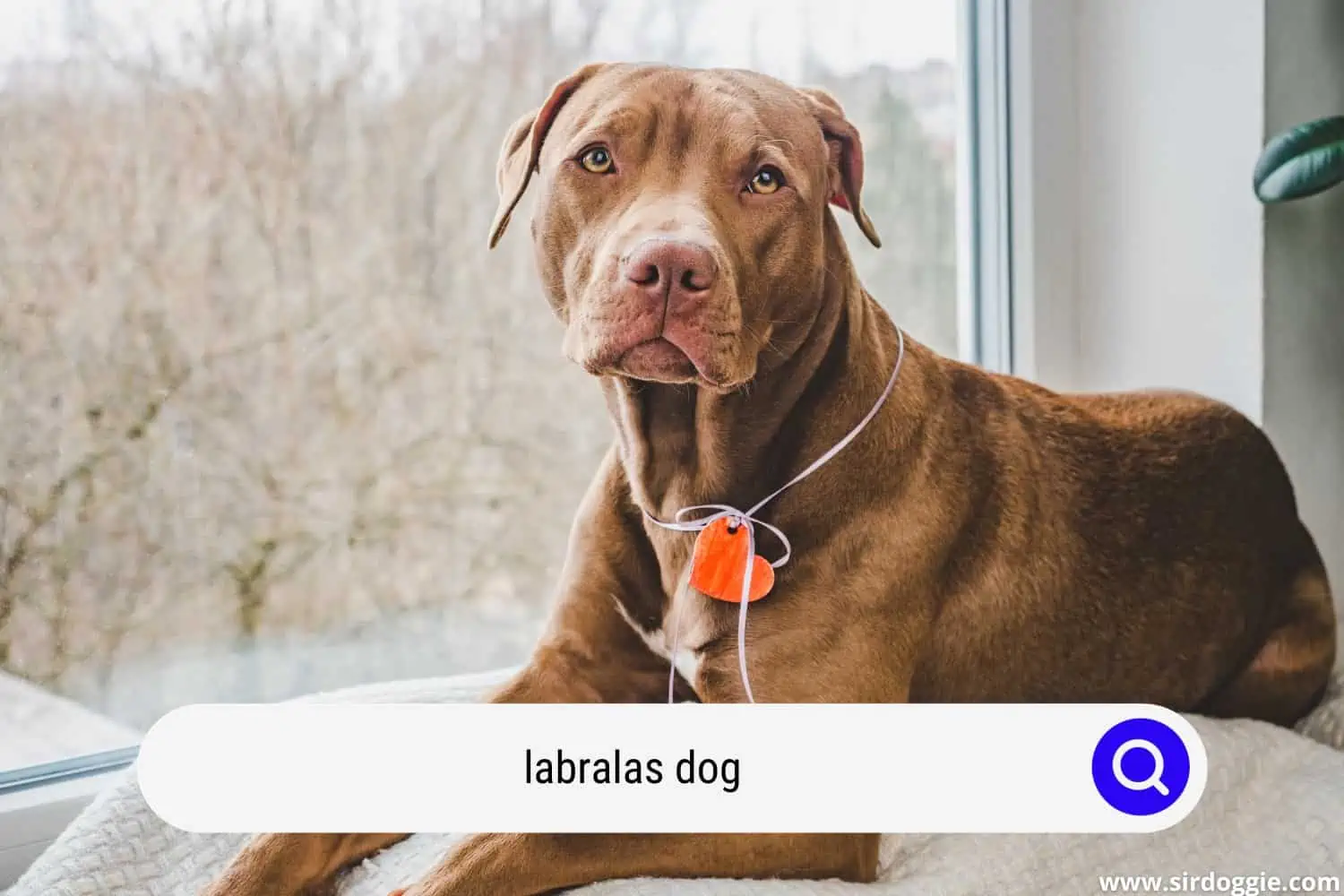Labralas: Vizsla and Labrador Retriever Mix A Complete Guide
A Labrala is a hybrid of the Labrador and shorthaired Vizsla. They are just like the crosses that produced the Labradoodle, the Borador, the Cavador, the Labrabull, and many more.

Labralas, also called Vizsladors and Vizsla Lab dogs, are mixed breed dogs that are specifically bred from a cross between a purebred Magyar Vizsla and a purebred Labrador Retriever.
These hybrid dogs are very sporty four-legged friends who possess the best qualities of the Labrador with those of the Vizslas.
The Labrador, which is now a popular family dog, was originally bred for fetching ducks. Magyar Vizsla are just as friendly dog breeds, but in contrast to the Labrador, they need a lot more exercise.
They are therefore more suitable for very sporty dog owners. The Labrala puppies also get this joy of movement. These dogs are lighter than the Labrador and therefore considerably more agile.
These Labrador Mix dogs are still very rare, but they are becoming more and more popular in some countries. In Canada, America, and England, it is now one of the most popular Labrador Mix dogs. They are especially found with dog owners who are looking for a sporty companion.
In general, one can say that the dog breeds Vizsla and Labrador complement each other very well. Should you choose a Labrala puppy, then you will have a new family member who is very intelligent, friendly, social, loves children, and likes to move around. First, let’s see what their parents are.
The Labrador Retriever
The Labrador Retrievers are medium-sized dogs very appreciated and originally used for hunting. Intelligence, sweetness, and cheerfulness characterize this type of dog breed.
The much-loved Labrador Retriever has been employed in breeding so-called designer dogs for several years. The most famous is the “Labradoodle”, a mix of Labrador and Poodle (Poodle).
The Vizsla (Hungarian pointer)
Like the Labrador, it is friendly, easy to train, intelligent, and also athletic.
This medium-sized specimen is a hunting dog that can adapt to different lifestyles, showing itself to be an excellent companion dog for the whole family.
Comparison table: Labralas vs Labrador retrievers and Vizsla
| Labralas | Labrador retriever | Vizsla | |
| Size | Weight: 22 to 36 kg Height: 53 to 63 cm | 25 to 36 kg Height: 55 to 62 cm | Weight: 20 to 30 kg Height: 53 to 60 inches |
| Temperament | Gentle, protective, energetic, affectionate, intelligent, sensitive | Friendly, active, outgoing | Affectionate, energetic, loyal, quiet, gently |
| Health problems | loose knee joints, elbow and hip dysplasia, torn ligaments in the hind legs, eye diseases, heart disease, epilepsy, cancer, and chronic allergies. | Lumps and bumps, cruciate ligament rupture, gastrointestinal disorders, hip and elbow dysplasia | epilepsy; blood clotting disorders; eye disorders; hip dysplasia; hypothyroidism; cancers. |
| Life expectancy | 10 to 14 years | 10 to 12 years | 12 to 15 years |
| Puppy price | $800 to $1,200 | $800 to $1,200 | $1,500 to $2,200 |
Related Reading: Vizsla vs Greyhound: What’s the Difference?
Labrala: Physical characteristics and appearance
Labrala dogs are bred from a cross between the Magyar Vizsla and the Labrador Retriever. The result is muscular, wiry hybrid dogs with pretty floppy ears.
Labradors have coat colors of black, yellow, or chocolate brown. Vizsla are mostly brown to light brown in fur. The coat colors of the Labrala can develop from chocolate brown, yellow, light brown to black.
Sometimes there are also Labrala puppies that are two-colored, but this is usually very rare. Its coat is short with a fairly straight coat.
The muzzle of this Labrador Mix dog is square like the Labrador’s and a little longer like the Vizsla. Its eyes can be chocolate brown or amber, with a black nose.
Bitches usually have a shoulder height of approx. 58-60 cm, males are always slightly larger and usually have a shoulder height of 60-65 cm. The weight of a Labrala dog is between 26 and 36 kg for the male and between 25 and 34 kg for the bitches.
Labrala: temperament & character
Labrador mixed breeds are intelligent, sensitive, and very sporty four-legged animals who need sufficient exercise and activity. Thanks to their intelligence, they learn quickly and are good at teaching tricks.
These Labrador mixes are best for sporty dog owners who always like to move around. Just walking and throwing balls will not keep the Labrala busy enough. The best thing to do is to go jogging, hiking, swimming, cycling, and maybe even regular dog sports.
Nevertheless, every Labrala puppy can develop a different temperament in the litter, depending on whether the Labrador or the Vizsla has prevailed.
But both dog breeds are friendly, easy to train, and social towards other dogs. It is only important to socialize your Labrala puppy early on. This puppy training works best with positive control and a few treats. Both the Vizsla and the Labrador have a strong “will to please” character, so if they are treated positively and praised, they learn faster.
In general, Vizsla Lab dogs are not aggressive, sometimes they develop a protective instinct towards strangers when it comes to their families. Also, these dogs have a hunting instinct. But you can train or practice this instinct so that your companion can be called up if a wild animal or cat crosses your path.
The Labrador Mix dogs are often used as rescue dogs and search dogs at customs. But they can also be used as therapy dogs in old people’s homes or with children.
It is best to keep your Labrador mongrel in a house with a garden, where it can be busy outside. Very active dog owners can also keep them in the apartment.
If you can provide your Labrala with enough work and activity, they will become such a wonderful family member.
The only important thing is not to leave it alone too much. It doesn’t like to wait all day at home alone till the master or mistress comes home from work.
Labrala: puppies & breeders
Vizsla Lab Mix puppies are not only cute but also wonderful companions. They grow up to be medium to large-sized dogs. At this stage of development, they need a lot of support from their caregivers to become a relaxed adult Labrala.
Therefore, take it to many places and visit a group of puppies regularly so that it can learn how to interact with other conspecifics at an early stage because Vizsla Lab puppies usually grow to become lively dogs that need a lot of time for socialization and upbringing, especially at the beginning. Failure to exercise your Labrala when it is young can lead to behavioral problems in old age.
When purchasing a Labrala puppy, it is important to buy it from a responsible breeder who has completed all of the major health checks on the parent animals. Also, the parent animals should have a relaxed and well-groomed impression.
The puppy should move out at the breeder’s place at the earliest after the eighth week. The puppies should be vaccinated and dewormed.
Also, a good breeder can help you choose a puppy and provide specific training tips for this Labrala breed. The price of a Labrala puppy will vary depending on the breeder.
Labrala: health and common diseases
Mixed breed dogs do not necessarily have the same health problems as their parent animals, but do tend to inherit the health problems from one of their purebred parents.
Therefore, one should consider the diseases of the parents and clarify them with the Labrala breeder before deciding on a puppy. Vizsla dogs are prone to hip dysplasia and Vizsla myositis, a muscle disorder that weakens the bite and masticatory muscles. Affected dogs have difficulty eating and vomiting.
The purebred Labrador can be prone to loose knee joints, elbow and hip dysplasia, torn ligaments in the hind legs, eye diseases, heart disease, epilepsy, cancer, and chronic allergies.
Particular attention should be paid to its nutrition as, if overweight, the joints will be put at additional risk, hence, developing dysplasia.
In general, however, one can say that the Labrala is more robust, healthier, and inherits fewer genetic disorders than its parents if these have been examined for hereditary diseases before crossing. Early health checks can help prevent or prepare for future health problems.
The parent animals must be checked for health before crossing to reduce the likelihood of genetic diseases. Parents of the Labrala should at least have been tested for hip dysplasia and eye diseases such as progressive retinal atrophy (PRA). PRA is a degenerative eye disease that causes gradual loss of vision.
The Labrala has a life expectancy of 10 to 14 years, just like other large breeds.
Care of the Labrala
Magyar Vizsla dogs and Labrador dogs have short, dense fur that loses quite a bit of fur at certain times of the year. Brushing out regularly at this time can help reduce hair in the household. Regular brushing is also important to maintain the coat of the Vizsla Lab dog.
In addition to brushing, you should brush its teeth regularly and wipe the ears with a damp cloth to avoid infection. You will also have to trim its nails every few months. You can tell whether its claws are too long as soon as its paws clack while walking on the parquet, for example.
You don’t need to give the dog an extra bath unless they have wallowed in something smelly.
Since the shedding and grooming are similar in both the Labrador and Magyar Vizsla, you can assume that the Labrala will need just as much grooming as its purebred parent animals.

Children & Labralas
The Labrala is well suited as a family dog, but it is a bit bustling and is therefore better with older children, whom it cannot run over so easily.
Many children dream of owning a dog, but they should slowly be introduced to each other. The children also have to be taught how to handle the animals sensibly. The dog should be left alone, especially when it is eating or sleeping.

Family Dog Expert Author
Hi there! I’m Stuart, a devoted dog lover and family dog expert with over a decade of experience working with our furry companions. My passion for dogs drives me to share my knowledge and expertise, helping families build strong, loving bonds with their four-legged friends. When I’m not writing for SirDoggie, you’ll find me hiking, playing with my beautiful dog, or studying music.